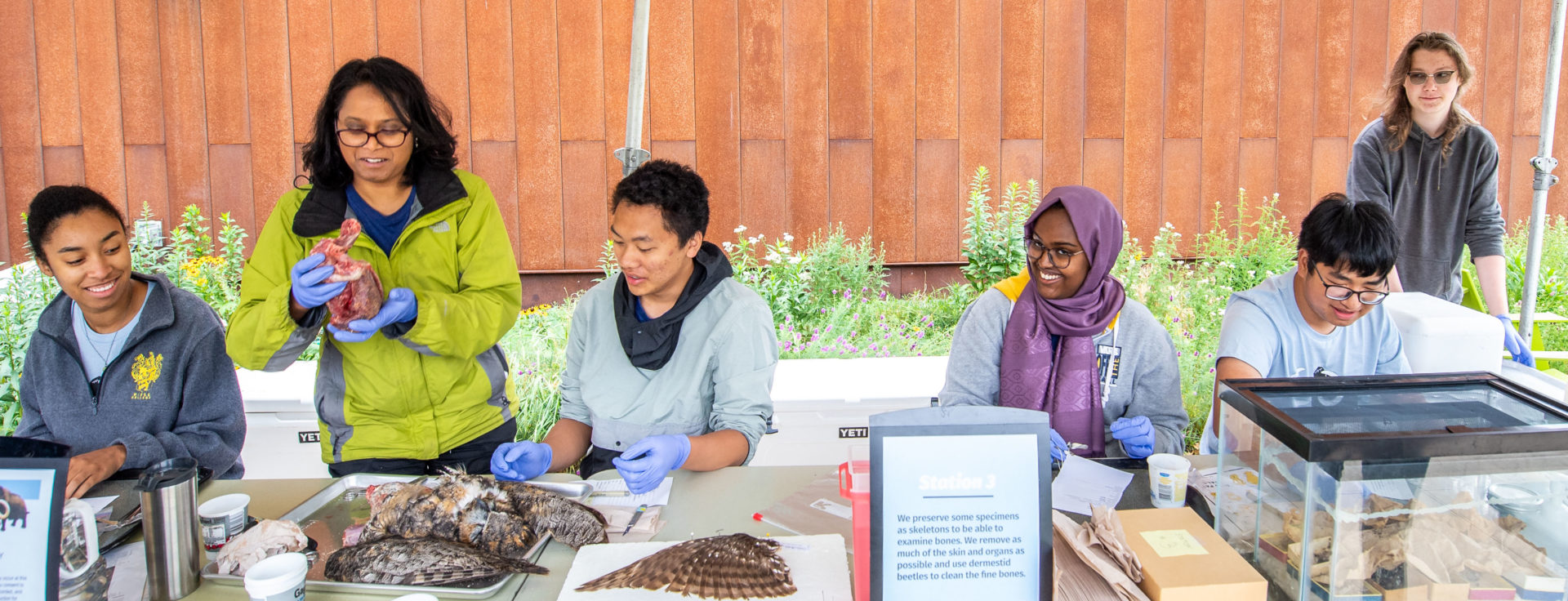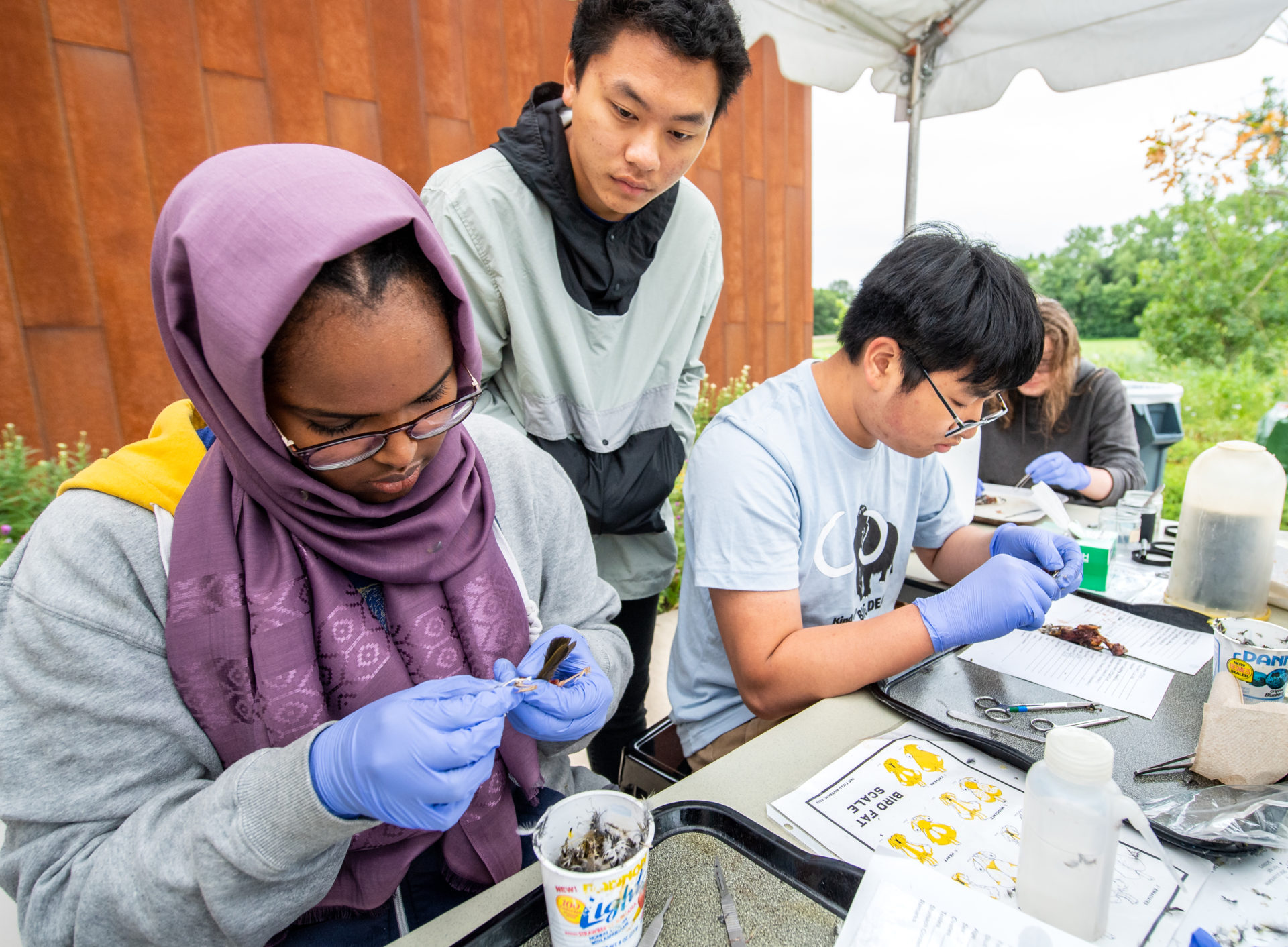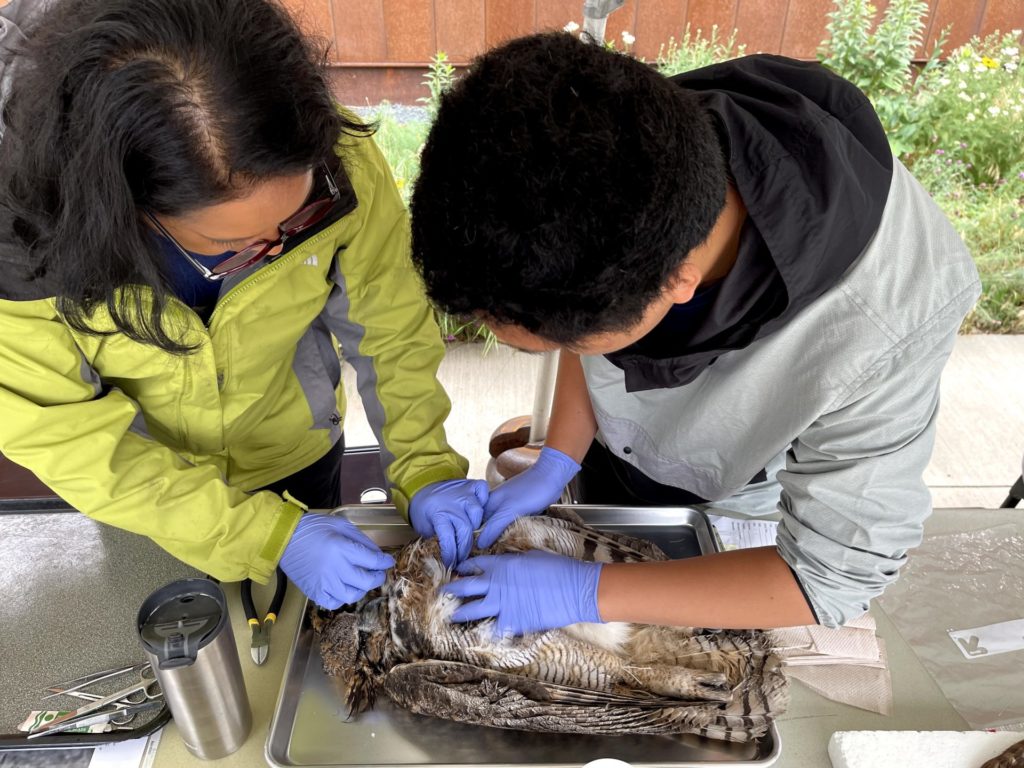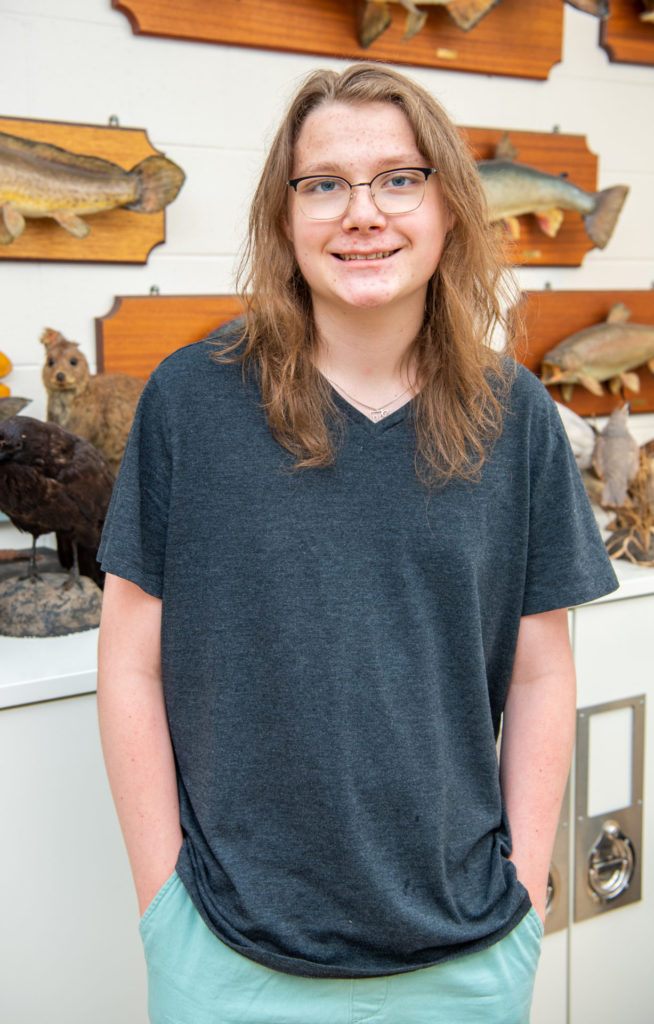
Career Exploration in Natural History: The Bell introduces a new internship program with a public outreach component
The Bell's new high school summer internship program provided hands-on experience with working in museum collections and insight into public outreach
Published09/14/2021 , by Emily Dzieweczynski
Have you ever considered a career in the natural sciences? What would it be like? Where would you start? What do scientists do in a natural history museum? The Bell Museum’s new internship program aims to shed light on these questions. Breckenridge Chair of Ornithology & Curator of Birds Sushma Reddy and Curator of Mammals Sharon Jansa piloted this program to explore ways of encouraging and inspiring more students to pursue careers in the natural sciences. By providing interns with hands-on experience within the Bell Museum’s collections, they quickly became knee-deep in the world of natural history (literally—suited in waders, the interns collected specimens from a pond!).
The interns were selected from high schools in areas where there are large populations of historically underrepresented communities in science and museums through the Right Track program. Through this paid opportunity, interns worked closely with museum staff, mentors, graduate students, and faculty to learn about careers in natural sciences. They contributed to the Bell’s natural history collections through dissection, specimen preparation, and data collection and even conducted some of their own research for a capstone project.

In addition to learning about the behind-the-scenes work of the Bell, interns also learned about public engagement and science communication. Bell staff members on the Public Engagement & Science Learning team met with the interns to help them build their science communication skills and think about public engagement in new ways. The interns also received mentoring from people such as Audrey Breland of the CORE program at the University of Minnesota.
All this work culminated in a public outreach event called Expeditions to the Bell. For two weeks, interns, mentors, and faculty met on the Bell’s Learning Landscape to provide live demonstrations of the specimen dissection and preparation process. While this process is such a central component of any natural history collection, it is often not at the forefront of natural history museums.

Expeditions to the Bell not only provided an opportunity for visitors to learn more about this vital process but also gave the interns a chance to practice their science communications skills. The interns excitedly demonstrated how scientists take various data, preserve different types of samples, and produce specimens for the Bell Museum’s natural history collection.
The interns’ work varied from day to day, resulting in no more than a few dull days and lots of highlights. For example, the interns were able to get outside and do fieldwork in a nearby stream, where they collected approximately 13 different fish species! Another highlight included preparing a Great Horned Owl specimen. Sushma and high school intern Chai worked on this massive project over the course of two days during the Expeditions to the Bell program and were able to share the process with many Bell visitors.

Thank you to all our interns, mentors, and staff who made this program possible!
Meet the Bell Museum Interns!
Meet Chai Qhas Yang!

Chai is a recent graduate from Johnson High School who will now be attending the University of Minnesota. His interests include fishing, aquarium fish keeping, and basketball.
Chai shared that this internship strengthened his resolve to pursue a career in Fisheries and Wildlife Biology and commit to the University of Minnesota. The hands-on experience that this internship offered was influential on Chai and he found that it cultivated a space for learning and discovery. “I believe the only way you would really like something is to experience it yourself, and I was able to do that with this internship. I can’t wait to see what the future holds and I can’t wait to discover and explore even more!”
Meet Subashri Buck!

Subashri is currently a senior at Harding High School. His hobbies include going to the dog park with his dog, camping with family, and playing baseball.
Subashri had originally anticipated days of dissecting animals and learning about the intricacies of natural history careers, but he was pleasantly surprised that they did a lot more hands-on learning of science than he had ever experienced before. Subashri mentioned that, as a result of this internship, he wants to learn more about and do more research on natural science topics in his free time.
Meet Kristian Her!

Kristian is in 11th grade at Harding High School. His hobbies and interests include games, manga, and camping.
Kristian was blown away by how vast the Bell’s behind-the-scenes collections are. For example, one of the strangest things he recalls was encountering the collections of fishes and salamanders—he was shocked by everything in jars! “This internship has definitely steered what I want to do with my life,” Kristian shared. Now, he wants to study biology, possibly even at the University of Minnesota. He encouraged future interns to take initiative and ask for help when you need it. “I just want to say this experience has really shifted my view on things and I will probably never forget this experience.”
Meet Fathuma Mohamed!

Fathuma will be a freshman at Stanford University this fall. She’s interested in geology because she wants to understand the connections between all the earth processes. She recalls one of her favorite classes as a PESO student at the University of Minnesota, called Geology and Cinema, where they explored how Hollywood butchers (and sometimes perfectly executed) geological and environmental processes. She recommends watching “10.0” to get a better understanding of what Hollywood has done in the name of entertainment.
Fathuma found it both fascinating and strange to work with specimens—small, dead mammals and birds—for the whole summer. She was thankful for the chance to be exposed to so many natural science departments and talk to mammalogists, paleontologists, and herpetologists, just to list a few. As a word of advice to the next year’s interns, Fathuma shared, “keep your mind open and willing to try new things. Ask many questions and let your passions and interests help lead you through your time here at the Bell and in life!”
Meet Ian Rosenberg-Scholl!

Ian is a student at Open World Learning Community. His interests include archery, architecture, and reading.
To Ian, the whole internship felt a bit like a summer camp because, in a lot of ways, it was more fun than work. He enjoyed the opportunity to be paid to learn and hone his collaboration skills while working with other interns. The Expeditions to the Bell program presented another chance to deepen his knowledge of the natural environment, as Ian explained that, “you learn more about the specimens you’re working on because when people ask you a bunch of questions, you have to know how to explain it.”
Meet Yonis Wehelie!

Yonis is a senior at Nova Classical Academy.
Over the course of the internship, Yonis became a pro at science communication. He shared that working with and preparing different specimens every day leading up to the Expeditions to the Bell program gave him the insight necessary to communicate with the public. Yonis also applied problem-solving skills on a daily basis to navigate the new and sometimes challenging tasks that the internship presented. Sushma shared that Yonis, along with all the other interns, displayed exceptional abilities in this category.
Meet the Bell Museum Mentors!
Meet Sean!

Sean is a PhD candidate in the Ecology, Evolution, and Behavior department at the University of Minnesota. He studies freshwater mussel shell shape evolution with a focus on adaptive morphological evolution.
Sean’s favorite part about working with the interns was seeing their hunger for learning new skills. “They took every opportunity possible to try something new,” said Sean. With this curiosity came great memories. Sean enjoyed seeing Chai and Sushma stuff a giant Great horned owl and Yonis explain to a young visitor that the bird he was dissecting sadly perished on the child’s birthday.
Meet Tom!
 Tom is a graduate student in the Ecology, Evolution, and Behavior department at the University of Minnesota. He studies the biogeography of salamanders. When he’s not studying, you’ll find him gardening!
Tom is a graduate student in the Ecology, Evolution, and Behavior department at the University of Minnesota. He studies the biogeography of salamanders. When he’s not studying, you’ll find him gardening!
Working with the interns was a bright part of Tom’s day. “They were hilarious. Every day they’d make me laugh hysterically,” he shared. Asking questions is a key part of this internship and Tom loved hearing all the questions the interns had when they were interacting with the curators. To coming interns, Tom shared, “come with a goal of what you want to learn, and we’ll try to get you there.”
Thank you to our supporters
This program has been generously supported by the WEM Foundation.

